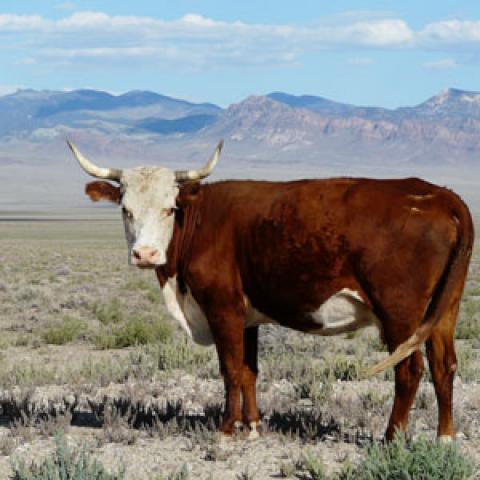In the West, we’ve seen this Cliven Bundy movie before. And with every re-run, the worn out story line of the heroic independent rancher standing up to the dictatorial federal government gets more tiresome.
Bundy, for those who have been paying attention to more important news, is the southern Nevada rancher who, after two decades of refusing to pay the ridiculously modest fees for grazing his cattle on federal land, provoked an armed standoff with the federal Bureau of Land Management when the agency’s employees came to confiscate Bundy’s cows. His stand attracted hundreds of self-described militiamen and other fringe-dwellers who couldn’t resist the siren call of what was portrayed as an honest-to-God western range war.
The notion of a range war is irresistible. It’s like an intravenous injection of the cowboy mythology that runs so deep in American history and which continues to distort our public lands policies to this day. Google “Cliven Bundy and range war” and you get close to a quarter million hits.
Google “Wayne Hage and range war” and you get almost 6.5 million hits. Some of them lead to stories I wrote in the 1990’s when I covered public lands issues for the Washington Post and Hage, another Nevada rancher, was in a long-running cattle battle with U.S. Forest Service and maniacally playing the range war card.
One of those stories began like this: “Cattleman Wayne Hage — rhymes with rage — is one angry cowboy.” Other than the rhyme, you could substitute Cliven Bundy for Wayne Hage and have pretty much the same story.
Hage ranched near the Humboldt-Toiyabe National Forest in Nevada, and leased grazing allotments on about three-quarters of a million acres of public land in the forest. He sparred over and over again with the Forest Service during the 1980s over his treatment of that federal land. The agency eventually canceled some of his permits and confiscated and sold more than 100 of his cows.
Hage then filed a lawsuit claiming compensation of $28 million for what he termed an unlawful taking of his property by the federal government which he said included his rights to water and forage on public land. Hage died in 2006, but his lawsuit lived on until the U.S. Court of Appeals for the Federal Circuit put an end to it and overturned an earlier $4.2 million judgment in Hage’s favor by the U.S. Court of Federal Claims.
As all of this legal tussling was going on, Hage wrote a book, “Storm Over Rangelands: Private Rights in Federal Lands.” One memorable line from the book: “Range War! Here and now!” was one I couldn’t resist putting in my story, too.
As High Country News reported in a chronology of the Hage case, he inspired other lawsuits and the Nevada ranchers who filed them all lost. Among them was Cliff Gardner from Elko County who fought all the way to the 9th U.S. Circuit Court of Appeals after the Forest Service revoked his grazing permit for abusing public land. Likewise Cliven Bundy, who was first ordered by a federal court to remove his cows from federal lands in 1998.
Some of the particulars of all these range war cases differ, but the basics are the same: ranchers who stubbornly insist the federal government doesn’t have the authority to tell them what they can do on public lands, that someone else — the state or the ranchers themselves — actually owns those lands.
This notion has been thoroughly discredited over and over again in the courts. The simple fact is, the hundreds of millions of acres managed by agencies like the Bureau of Land Management and the U.S. Forest Service are owned by the public and how they are used is determined by laws approved by Congress and carried out by the agencies.
When renegade ranchers don’t play by the rules — and the federal agencies have gotten better about requiring more environmentally sound grazing practices after decades of damaging ones — those ranchers get punished. It’s called the rule of law.
It’s not like the deal is so bad for public lands ranchers, either. Right now they are paying $1.35 a month for each cow/calf combination eating our grass. By comparison, the average grazing fee on private land in the West is $16.80 a month, according to the Congressional Research Service, and ranges between $2.28 and $150 on state lands in the region.
The federal lands grazing program is like supercharged food stamps for bovines. And it is massively subsidized. As the U.S. Government Accountability Office reported in 2005, the program brought in $21 million in fees paid by ranchers, but cost $144 million to run.
If Cliven Bundy had paid his grazing fees, it would have narrowed that gap. But not by much.
Tom Kenworthy is a Senior Fellow at American Progress. He joined American Progress after spending two years as a senior fellow at Western Progress, a regional nonpartisan policy institute in the Rocky Mountain West, where he focused on renewable energy and environmental issues. Tom spent more than three decades as a newspaper reporter, the majority of that time with The Washington Post and USA Today. His longtime specialties were public lands, natural resources, and energy issues, which he covered as a Denver-based national correspondent beginning in 1995. His environmental reporting has won awards from the Society of American Foresters and the Sierra Club. As a policy analyst. Tom holds a B.A. in history from Cornell University in 1970. He lives in Golden, Colorado, with his wife, Nancy. Twitter: @sawmillcreekCO


Spread the word